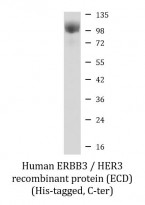ARG70242
Human ERBB3 / HER3 recombinant protein (ECD) (His-tagged, C-ter)
Human ERBB3 / HER3 recombinant protein (ECD) (His-tagged, C-ter) for Binding Activity,SDS-PAGE and Human
Overview
| Product Description | HEK293 expressed, His-tagged (C-ter) Human ERBB3 / HER3 recombinant protein (ECD). |
|---|---|
| Tested Reactivity | Hu |
| Tested Application | Binding, SDS-PAGE |
| Target Name | ERBB3 / HER3 (ECD) |
| Species | Human |
| A.A. Sequence | Ser20 - Thr643 of Human ERBB3 / HER3 (NP_001973.2) with 6X His tag at the C-terminus. |
| Expression System | HEK293 |
| Alternate Names | MDA-BF-1; LCCS2; p180-ErbB3; Proto-oncogene-like protein c-ErbB-3; c-erbB3; p85-sErbB3; Tyrosine kinase-type cell surface receptor HER3; p45-sErbB3; erbB3-S; HER3; c-erbB-3; ErbB-3; EC 2.7.10.1; Receptor tyrosine-protein kinase erbB-3 |
Application Instructions
| Application Note | Binding activity test: Measured by its binding ability in a functional ELISA. Immobilized Recombinant Human ERBB3 at 2µg/ml (100µl/well) can bind Recombinant Human NRG1-beta1 with a linear range of 0.128-45.7 ng/ml. |
|---|
Properties
| Form | Powder |
|---|---|
| Purification Note | 0.22 µm filter sterilized. Endotoxin level is <0.1 EU/µg of the protein, as determined by the LAL test. |
| Purity | >97% (by SDS-PAGE) |
| Buffer | PBS (pH 7.4) |
| Reconstitution | Reconstitute to a concentration of 0.1 - 0.5 mg/ml in sterile distilled water. |
| Storage Instruction | For long term, lyophilized protein should be stored at -20°C or -80°C. After reconstitution, aliquot and store at -20°C for up to one month, at 2-8°C for up to one week. Storage in frost free freezers is not recommended. Avoid repeated freeze/thaw cycles. Suggest spin the vial prior to opening. |
| Note | For laboratory research only, not for drug, diagnostic or other use. |
Bioinformation
| Gene Symbol | ERBB3 |
|---|---|
| Gene Full Name | erb-b2 receptor tyrosine kinase 3 |
| Background | This gene encodes a member of the epidermal growth factor receptor (EGFR) family of receptor tyrosine kinases. This membrane-bound protein has a neuregulin binding domain but not an active kinase domain. It therefore can bind this ligand but not convey the signal into the cell through protein phosphorylation. However, it does form heterodimers with other EGF receptor family members which do have kinase activity. Heterodimerization leads to the activation of pathways which lead to cell proliferation or differentiation. Amplification of this gene and/or overexpression of its protein have been reported in numerous cancers, including prostate, bladder, and breast tumors. Alternate transcriptional splice variants encoding different isoforms have been characterized. One isoform lacks the intermembrane region and is secreted outside the cell. This form acts to modulate the activity of the membrane-bound form. Additional splice variants have also been reported, but they have not been thoroughly characterized. [provided by RefSeq, Jul 2008] |
| Function | Tyrosine-protein kinase that plays an essential role as cell surface receptor for neuregulins. Binds to neuregulin-1 (NRG1) and is activated by it; ligand-binding increases phosphorylation on tyrosine residues and promotes its association with the p85 subunit of phosphatidylinositol 3-kinase (PubMed:20682778). May also be activated by CSPG5 (PubMed:15358134). Involved in the regulation of myeloid cell differentiation (PubMed:27416908). [UniProt] |
| Cellular Localization | Isoform 1: Cell membrane; Single-pass type I membrane protein. Isoform 2: Secreted. [UniProt] |
| Calculated MW | 148 kDa |
| PTM | Autophosphorylated (PubMed:20351256). Ligand-binding increases phosphorylation on tyrosine residues and promotes its association with the p85 subunit of phosphatidylinositol 3-kinase (PubMed:20682778). [UniProt] |
Images (1) Click the Picture to Zoom In






